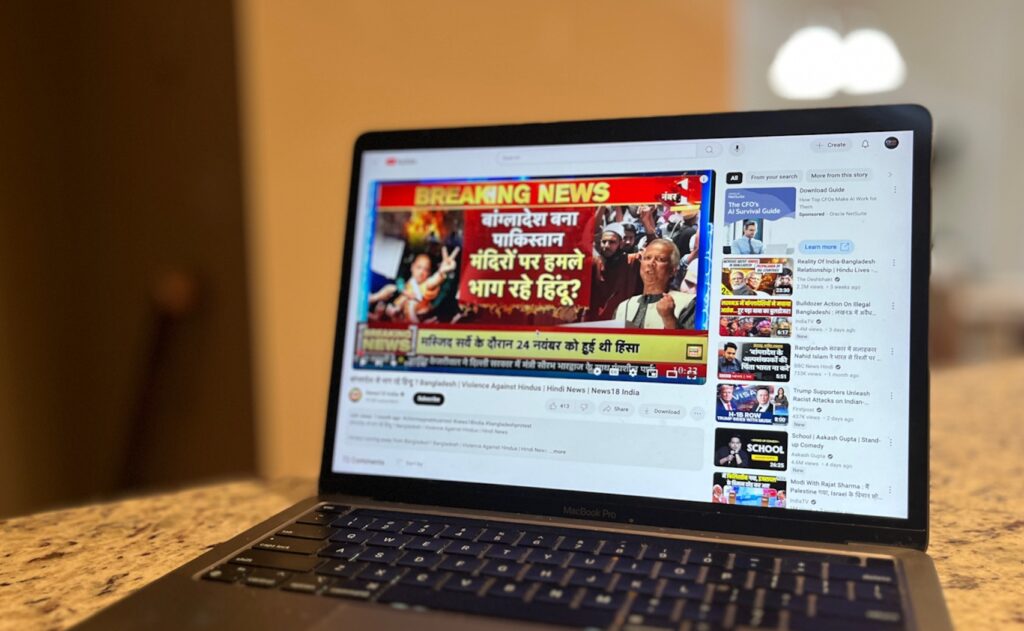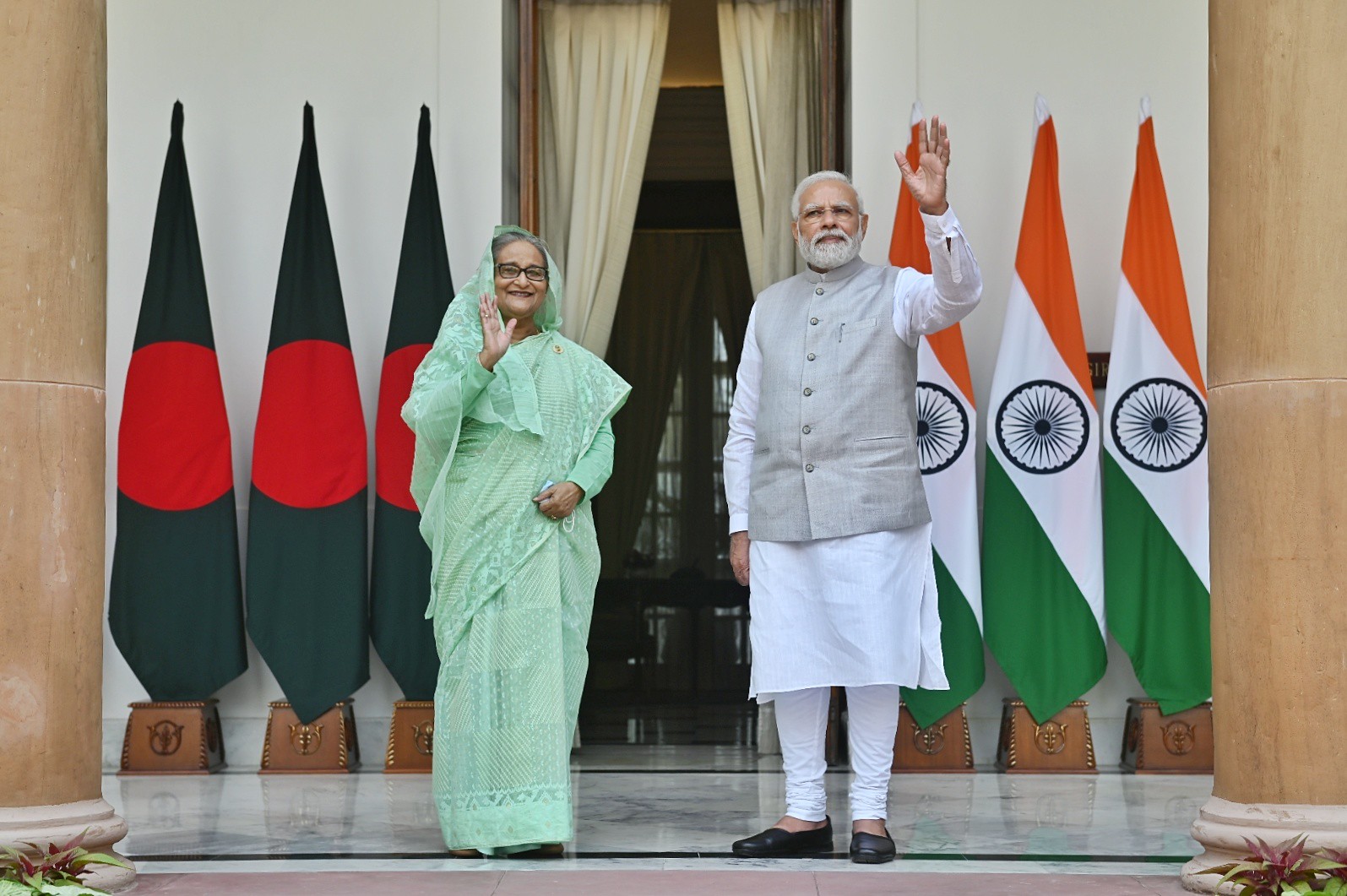On December 2, 2024, a storm of misinformation sweeping across South Asia ignited a shocking act. Following the arrest of monk Chinmoy Krishna Das, a Hindu mob vandalized the Bangladesh diplomatic compound in Agartala, India. The monk, formerly associated with the International Society of Krishna Consciousness (ISKCON), was charged with sedition over alleged disrespect of Bangladesh’s national flag. Indian media portrayed Das’s arrest as the persecution of minority Hindus in Bangladesh, compounding tensions by falsely stating that a mob had killed his Muslim lawyer. Fact-checkers from India and Bangladesh debunked claims that the Muslim lawyer represented Das at all, but the damage had already been done. The incident highlights the dangerous role of cross-border misinformation in escalating communal hostility.
Indian media’s misinformation campaign has had far-reaching consequences, inciting violence in India and protests in neighboring Nepal and Bangladesh. These events demonstrate how false narratives are not confined to borders, escalating tensions in a region already fraught with historical grievances. Diplomatic relations between Dhaka and New Delhi have grown increasingly strained, particularly after the ousting of Sheikh Hasina’s government following student-led protests in mid-2024. Accusations regarding the protection of minorities in both countries have fueled mutual distrust, complicating efforts for dialogue and cooperation.
Hasina’s 15-year autocratic rule, marked by allegations of corruption and human rights abuses, ended in an uprising that claimed over 1,000 lives. Her government’s perceived alignment with India’s Hindu nationalist government alienated many in Bangladesh, where anti-Indian sentiment has deep roots. The interim government, led by Nobel Laureate Mohammad Yunus, who presides over a cabinet of technocrats, civil society, and student leaders, is viewed with suspicion in India, particularly by right-wing media. Toeing the national Indian government line, Indian media has framed the political shift as a loss of secularism. It went as far as portraying the uprising as driven by Islamists and the former opposition Bangladesh Nationalist Party (BNP).
India played a key role in Bangladesh’s Liberation War of 1971, but historical grievances and India’s overt support for Hasina’s regime have sown seeds of distrust. This distrust has been amplified by Indian media’s portrayal of the current political turmoil as a persecution against Hindus.
Vishal Arora, an Indian journalist, identifies confirmation bias in newsrooms as a significant hurdle. “Unfortunately, confirmation bias often overrides factual accuracy in determining what is perceived as truth. There’s no universal agreement within the media industry about the extent of research or verification necessary for a media organization,” he said, drawing a parallel with the judicial system, which, according to him, sometimes wrongfully acquits or penalizes individuals based solely on documentary evidence.
In late November of 2024, media outlets, including India’s top news channels like Republic TV, Zee News, and India Today made false claims about the slain Muslim lawyer over his now-disproved affiliation to the Hindu monk. Other right-wing Indian media organizations joined the chorus, using terms such as “bloodbath” to describe the alleged persecution of Hindu minorities in the country. “Yunus Is Presiding Over A Bloodbath Against Hindus In Bangladesh. How India Can—And Must—Stop It,” read the headline of a piece published in Swarajya Magazine, a right-wing monthly news portal.
Earlier in August, following the fall of Hasina, an article in News18 headlined, “Hindu Massacres in Bangladesh: An Ongoing Genocide That is Rarely Discussed.” The article mostly covered the events between the 1947 partition that triggered massacres in India and Pakistan and atrocities during Bangladesh’s 1971 liberation war. But when framed with the current turbulence in the country, the clickbait headline overplayed the word “genocide,” falsely portraying it as if it were happening after the July uprising.

The spread of misinformation extended beyond India and Bangladesh. In Nepal, the Vishwa Hindu Federation organized protests outside the Bangladesh Embassy in Kathmandu, fueled by narratives of Hindu persecution. Similarly, in the U.K., Conservative MP Bob Blackman raised concerns in Parliament, asserting that “Hindus across Bangladesh are being subject to death, their houses and temples burned.” These claims, often exaggerated or unfounded, exacerbated existing fears within minority communities and strained India-Bangladesh ties. In his Diwali message, the U.S. President-elect Donald Trump condemned it on X, calling it “barbaric violence against Hindus, Christians, and other minorities who are getting attacked and looted by mobs in Bangladesh, which remains in a total state of chaos.”
Experts have challenged these narratives. Sumon Rahman, a professor of Media Studies at the University of Liberal Arts Bangladesh, said anti-Indian sentiment predates the current misinformation campaign. “There were protests against Indian media in Bangladesh, but the more significant one is something else: the Islamist parties showed unprecedented patience and did not fan the flame of communalism at all,” he said.
Large-scale violence did occur in the aftermath of the uprising against Hasina’s authoritarian regime, with police officers abandoning their posts. Forty-four police officers were killed during the protest, according to a report by Prothom Alo. The interim government soon restored law and order and does appear proactive in its efforts to prevent communal violence.
An investigation by Netra News, an investigative journalism outlet run by Bangladeshi journalists in exile, disputed the Bangladesh Buddhist Christian Unity Council’s claim of 2,000 incidents of communal violence and 69 Hindu deaths between August 4th and 10th. The investigation revealed that many incidents labeled as communal violence were driven by political or personal motives rather than religious tensions. Journalist Vishal Arora, who visited Bangladesh post-uprising, said of the alleged attacks: “Attacks were driven by political vendettas and local disputes, not religious animosity.”
Despite these findings, fear persists among Bangladesh’s Hindu minority, who constitute 8% of the population. Al Jazeera English’s recent reporting highlighted their anxiety, with Hindus fearing retribution in the aftermath of the uprising. French news agency AFP reported on a Hindu temple attack that left the community shaken. While the interim government has taken steps to prevent violence, including ensuring peaceful Durga Puja celebrations for Hindus in October, the narratives of persecution persist.
The misinformation campaign has far-reaching implications for India-Bangladesh relations. India’s decision to provide sanctuary to the deposed PM Hasina and Bangladesh Awami League leaders further complicates matters, fueling suspicions in Dhaka. The interim government’s call for Hasina to face trial for the killings of protesters highlights the fragile state of bilateral ties.
Critics argue that Indian media’s portrayal of Hindu persecution aligns with the Bharatiya Janata Party’s Hindu nationalist political agenda. Sumon Rahman, who also leads the fact-checking outlet Fact Watch, said, “Misinformation campaigns by Indian right-wing media have a significant impact on regional diplomacy, aligning with domestic political goals in India.”
Vishal Arora, who also heads the digital platform Newsreel Asia, spoke of the danger of framing Hindus as universally persecuted, “…given that Hindu persecution there is as real as the persecution of Muslims and Christians in India. However, it’s problematic to use this fact to portray Hindus as a widely persecuted community, including in India,” he said.
As Bangladesh grapples with the fallout of the misinformation campaign from Indian media, addressing the crisis requires more than simply debunking falsehoods. It demands regional collaboration, a commitment to ethical journalism, and proactive measures from both nations. Strengthening fact-checking initiatives across borders, encouraging partnerships between Indian and Bangladeshi media outlets, and ensuring the adoption of industry-wide standards for fact verification are critical steps to counter disinformation effectively. To counter cross-border misinformation, countries must promote digital literacy to empower citizens to identify falsehoods, and leverage technology to detect disinformation at scale.
